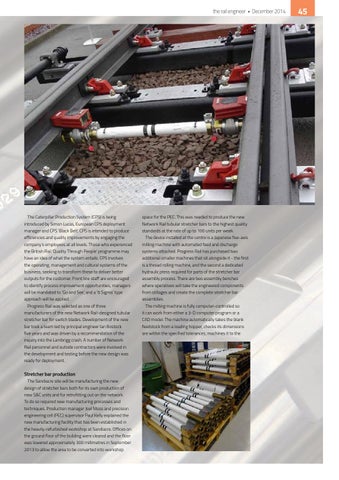the rail engineer • December 2014
The Caterpillar Production System (CPS) is being introduced by Simon Lucas, European CPS deployment manager and CPS ‘Black Belt’. CPS is intended to produce efficiencies and quality improvements by engaging the company’s employees at all levels. Those who experienced the British Rail ‘Quality Through People’ programme may have an idea of what the system entails. CPS involves the operating, management and cultural systems of the business, seeking to transform these to deliver better outputs for the customer. Front line staff are encouraged to identify process improvement opportunities, managers will be mandated to ‘Go and See’, and a ‘6 Sigma’ type approach will be applied. Progress Rail was selected as one of three manufacturers of the new Network Rail-designed tubular stretcher bar for switch blades. Development of the new bar took a team led by principal engineer Ian Bostock five years and was driven by a recommendation of the inquiry into the Lambrigg crash. A number of Network Rail personnel and outside contractors were involved in the development and testing before the new design was ready for deployment.
Stretcher bar production The Sandiacre site will be manufacturing the new design of stretcher bars both for its own production of new S&C units and for retrofitting out on the network. To do so required new manufacturing processes and techniques. Production manager Joel Moss and precision engineering cell (PEC) supervisor Paul Kelly explained the new manufacturing facility that has been established in the heavily-refurbished workshop at Sandiacre. Offices on the ground floor of the building were cleared and the floor was lowered approximately 300 millimetres in September 2013 to allow the area to be converted into workshop
space for the PEC. This was needed to produce the new Network Rail tubular stretcher bars to the highest quality standards at the rate of up to 100 units per week. The device installed at the centre is a Japanese five-axis milling machine with automated feed and discharge systems attached. Progress Rail has purchased two additional smaller machines that sit alongside it - the first is a thread rolling machine, and the second a dedicated hydraulic press required for parts of the stretcher bar assembly process. There are two assembly benches where operatives will take the engineered components from stillages and create the complete stretcher bar assemblies. The milling machine is fully computer-controlled so it can work from either a 3-D computer program or a CAD model. The machine automatically takes the blank feedstock from a loading hopper, checks its dimensions are within the specified tolerances, machines it to the
45
